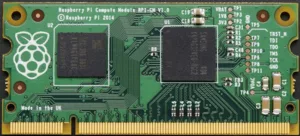NEC Display Solutions in Europe has announced that it will introduce a new range of large format displays (LFDs) that will extend its history of supporting modular solutions by allowing the displays to be fitted with a Raspberry Pi module, under the name “Open Modular Intelligence”.

 NEC’s Thomas WalterAt a distributor and partner event, which was streamed online from Rome, Thomas Walter of NEC introduced Eben Upton, one of the inventors of the Raspberry Pi which NEC will include in new ranges of large format displays.
NEC’s Thomas WalterAt a distributor and partner event, which was streamed online from Rome, Thomas Walter of NEC introduced Eben Upton, one of the inventors of the Raspberry Pi which NEC will include in new ranges of large format displays.
The Pi was introduced to make it easier for young people to access computers and has been a big success. At its launch in 2012, it sold 100,000 on the first day and a million in the first year, and over 10,000,000 to date. Since the launch, from being a very basic system, the Pi has evolved to its third revision, which uses an ARM 64 bit quad core processor, running at 1.2GHz and with at least 1GB of RAM. The third version was launched in February 2016 and is being widely used in education, by hobbyists and, increasingly in industry.
 Raspberry Pi’s Eben UptonA couple of years ago, a new configuration of Pi was developed, the Raspberry Pi Compute Module, a very small form factor, with less I/O (available for development on an optional I/O board) and based on an SO DIMM edge connector and form factor. Just after announcing the Raspberry Pi 3, with the 1.2GHz processor, an announcement was made about a version of the Module that will have the same core technology (although it is not currently available in that version, as far as we can see). There will be a module with 4GB of flash memory and 1GB of RAM generally available and NEC will create a version with 16GB of Flash which has been developed with Premier Farnell for around 18 months.
Raspberry Pi’s Eben UptonA couple of years ago, a new configuration of Pi was developed, the Raspberry Pi Compute Module, a very small form factor, with less I/O (available for development on an optional I/O board) and based on an SO DIMM edge connector and form factor. Just after announcing the Raspberry Pi 3, with the 1.2GHz processor, an announcement was made about a version of the Module that will have the same core technology (although it is not currently available in that version, as far as we can see). There will be a module with 4GB of flash memory and 1GB of RAM generally available and NEC will create a version with 16GB of Flash which has been developed with Premier Farnell for around 18 months.
The Raspberry Pi Compute Module
NEC will have a new series of displays (40″, 48″ and 55″ units in January with three more sizes up to 98″ later) that have an internal slot to accommodate the Module. Upton said that the Compute Module connector would remain the same for a good time into the future to allow long term product compatibility for future upgrades.
NEC Has Supported Open Interfaces
NEC was a developer, with Intel, of the original OPS slot (designed to allow a modular PC or optional interface to be fitted to a large display, projector or monitor) which was launched in 2012 and has been widely adopted. There is a good range of modules available from display makers and plenty of third party companies. The original OPS slot was joined by a mini-OPS slot this summer, developed by Intel and Sharp that is smaller (although as we remarked at the time, no thinner which was a surprise).
In response to questions at the launch event, Walter said that the slot for a Compute Module would be in addition to OPS slots, rather than simply replacing them.
Analyst Comment
I see this as quite an elegant solution for NEC. The company is not in the TV business, unlike competitors that are in the digital signage business like Samsung, LG and Philips, so it has not had the economies of scale to simply exploit technology developed for Smart TVs, as the others have been able to do. By adopting Pi, NEC is able to exploit the volume of the Pi to keep costs relatively down (the older Compute Module is currently selling for less than $30) and offer a level of price and performance that is competitive.
This will give flexibility. However, the Raspberry Pi is flexible on what OS is installed. The Pi is used with Linux, but different versions are available and so it wasn’t clear at the time of writing whether NEC’s own module will have a standard software installation that will allow certification of apps on the platform.
Update
NEC said that just after publication that its own version of the module will ship with a Raspbian configuration of Linux and will be tested with common apps, but there will be no certfication process. (BR)
Update 2
We corrected this article to change the specification for memory. (BR)

